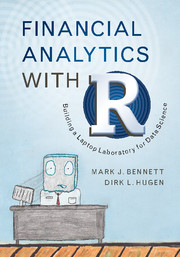Book contents
- Frontmatter
- Dedication
- Contents
- Preface
- Acknowledgments
- 1 Analytical Thinking
- 2 The R Language for Statistical Computing
- 3 Financial Statistics
- 4 Financial Securities
- 5 Dataset Analytics and Risk Measurement
- 6 Time Series Analysis
- 7 The Sharpe Ratio
- 8 Markowitz Mean-Variance Optimization
- 9 Cluster Analysis
- 10 Gauging the Market Sentiment
- 11 Simulating Trading Strategies
- 12 Data Exploration Using Fundamentals
- 13 Prediction Using Fundamentals
- 14 Binomial Model for Options
- 15 Black–Scholes Model and Option-Implied Volatility
- Appendix Probability Distributions and Statistical Analysis
- References
- Index
14 - Binomial Model for Options
Published online by Cambridge University Press: 20 October 2016
- Frontmatter
- Dedication
- Contents
- Preface
- Acknowledgments
- 1 Analytical Thinking
- 2 The R Language for Statistical Computing
- 3 Financial Statistics
- 4 Financial Securities
- 5 Dataset Analytics and Risk Measurement
- 6 Time Series Analysis
- 7 The Sharpe Ratio
- 8 Markowitz Mean-Variance Optimization
- 9 Cluster Analysis
- 10 Gauging the Market Sentiment
- 11 Simulating Trading Strategies
- 12 Data Exploration Using Fundamentals
- 13 Prediction Using Fundamentals
- 14 Binomial Model for Options
- 15 Black–Scholes Model and Option-Implied Volatility
- Appendix Probability Distributions and Statistical Analysis
- References
- Index
Summary
Derivative securities provide a flexible and more sophisticated exposure to the market than simply owning the stock. In this section, we will concern ourselves with a particular type of derivative security known as an option. Options give the purchaser the right, but not the obligation, to purchase or sell the underlying security at a given price. This right will expire at the maturity date.
That is correct: the user of the option can determine the price that they want to pay for the underlying security. However, there is no guarantee that the price of the underlying will be reached, and so the proposal can become worthless when it reaches its expiration. Additionally, there is a fee for having this right. It is known as the option premium.
With American options, the right to exercise can occur at any time of any date after the purchase of the option. With European options, the right to exercise can only occur at maturity (Hull, 2006).
When one owns a stock, they are subjected to all the highs and the lows that can occur while holding the position. With an option, however, one is only subject to exposure in either the long (call) or short (put) direction. Valuing options is a non-trivial exercise due to the stochastic nature of the underlying security. A relatively simple option model which is used quite often in the options trading world is called the binomial tree. Our purpose here is to help explain how options operate so we can build an analytics framework later.
Applying Computational Finance
In computational finance, one uses probability and statistics to reason about financial instruments in algorithms. In order to makes sense of the binomial tree and another related model called the binomial asset pricing model, we assume investors in securities:
• Keep bank accounts;
• Invest in underlying securities like stocks.
In our case here, the best way to illustrate the options market is using an option trading game. Hypothetical stock investor, Smitty, believes in increased demand for GOOG stock, buys 1 share on Monday (t = 0), sells on Friday (t = T); GOOG has 50–50 probability of going up (p) or down (q) by $1 per day. GOOG stock is trading at $800 per share on Monday.
- Type
- Chapter
- Information
- Financial Analytics with RBuilding a Laptop Laboratory for Data Science, pp. 318 - 330Publisher: Cambridge University PressPrint publication year: 2016



